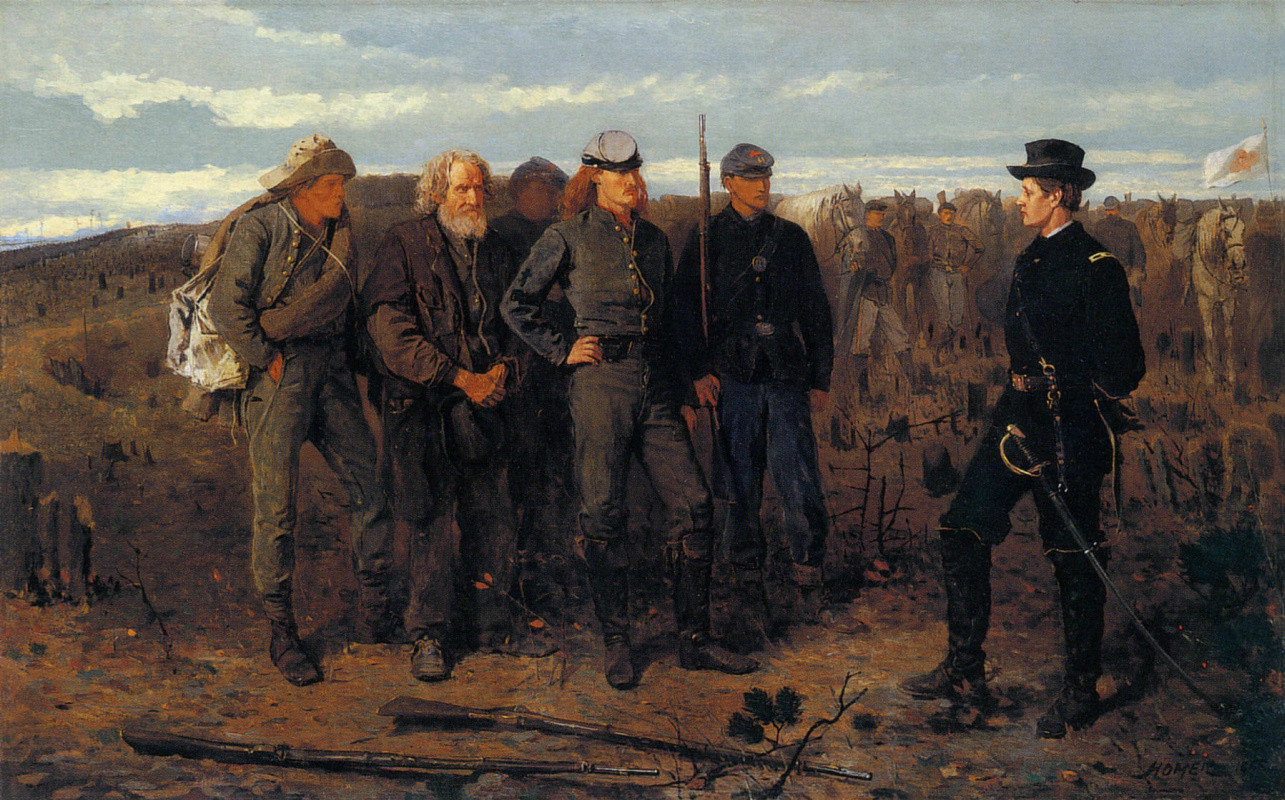log in
Enter site
Login to use Arthive functionality to the maximum
Prisoners from the front
Winslow Homer • Painting, 1866, 61×96.5 cm
Description of the artwork «Prisoners from the front»
Homer only began to paint war subjects in oil after the battles of the Civil War had already been left behind. The artist began filling the rather sketchy drawings, which he made during the war with little attention to details, with life and colour. But, despite the seeming negligence, these contrasting and expressive sketches of wartime accurately convey the mood and characters of the heroes in an amazing way.
After the war, the artist worked on his oil canvases much more carefully and in detail (infra-red photographs and numerous studies of the Prisoners from the Front showed that it underwent a lot of changes before it was completed). He managed to create such a breathing picture by combining tiny nuances, so that the viewer seems to easily hear the dialogue of the people depicted in it. There are few battle scenes in Homer’s military paintings, it seems that the artist is more interested in the other side, behind the scenes of the war, the notorious “human factor”. The battlefield in Petersburg, Virginia, which serves as the backdrop in Prisoners from the Front, attracts attention except by the felled trees and not primarily. The main focus here is not even on the people depicted on the canvas, but rather on a deep emotional drama.
The Prisoners from the Front painting depicts not only real people, but even a specific day — 21 June 1864, when an officer of the Union army, General Francis Channing Barlow (1834—1896) took several Confederates prisoner. Homer masterfully portrayed how different were the people who had been involved in this war: here is a young insecure boy, and a grey-bearded old man humbly accepting his fate. But the man who is still dressed in the Confederate army uniform deserves special attention. His proud, defiant posture almost mirrors General Barlow’s martial bearing. There was almost palpable tension between the officers, but the similarities between them, according to critics, are intended to emphasize a sense of unity, despite the fact that they are considered enemies.
Author: Yevheniia Sidelnikova
After the war, the artist worked on his oil canvases much more carefully and in detail (infra-red photographs and numerous studies of the Prisoners from the Front showed that it underwent a lot of changes before it was completed). He managed to create such a breathing picture by combining tiny nuances, so that the viewer seems to easily hear the dialogue of the people depicted in it. There are few battle scenes in Homer’s military paintings, it seems that the artist is more interested in the other side, behind the scenes of the war, the notorious “human factor”. The battlefield in Petersburg, Virginia, which serves as the backdrop in Prisoners from the Front, attracts attention except by the felled trees and not primarily. The main focus here is not even on the people depicted on the canvas, but rather on a deep emotional drama.
The Prisoners from the Front painting depicts not only real people, but even a specific day — 21 June 1864, when an officer of the Union army, General Francis Channing Barlow (1834—1896) took several Confederates prisoner. Homer masterfully portrayed how different were the people who had been involved in this war: here is a young insecure boy, and a grey-bearded old man humbly accepting his fate. But the man who is still dressed in the Confederate army uniform deserves special attention. His proud, defiant posture almost mirrors General Barlow’s martial bearing. There was almost palpable tension between the officers, but the similarities between them, according to critics, are intended to emphasize a sense of unity, despite the fact that they are considered enemies.
Author: Yevheniia Sidelnikova



